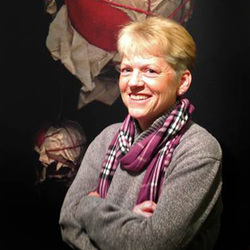First developed in the 1970s, digital photography appeared in two kinds of image-capturing devices: standard digital cameras and scanners. A digital camera captures an entire subject in one single exposure. A scanner however, captures an image by use of a sequence. The scanner's sensor moves over the subject and photographs it line by line. This is assembled into a composite image using software. These inventions have allowed photographers to push the bounds of photography. The work I do is sometimes referred to as Scanography or Scanner Photography.
Since these technologies were first developed, artists have been working with them and experimenting with a wide variety of possibility. Digital camera technology became a mainstream technology quickly. It has in fact more or less replaced film photography for common use. Why not? Once you have a digital camera you don't have the expense of film and making prints of every image. You also don't need ever deal with harsh and environmentally difficult chemistry. Digital cameras are pervasive and even built into our phones. We've become an image driven society whether we acknowledge it or not. In fact, the term "selfie" was added to the dictionary recently. Still, not all digital photographs are art and not all digital photographers are artists. There is more to an image than its technology.
Scanner technology on the other hand, is not quite so mainstream. One might have a scanner in their home but odds are if you do it is likely part of a scan-print-fax office machine. And while that is a form of scanner it isn't the type of scanner that I use. I use a flatbed photographic scanner. The kind made for scanning film, slides and images. It has the capability to scan at very high resolutions which can yield impressive detail in an image.
I recently read about an artist who has created a slit scan camera of his own using the sensor from a scanner like mine. He also developed some very interesting software to create his fantastic body of work. This Hungarian artist, Adam Magyar, has created a body of work including images created in the New York Subway system that are remarkable. HIs project, called Stainless, created high resolution imagery of speeding subway trains and passengers seemingly suspended in time. The images are hauntingly beautiful and are filled with a detail that no ordinary camera can capture. This is one of the things that excites me about scanner technology as a tool for art making. The imagery can capture more than a standard digital camera can see and record. It is both a celebration of minute detail and that which we do not ordinarily notice or see. Check out Adam's work. It's very different than mine but it shares a common thread, a scanner.
Since these technologies were first developed, artists have been working with them and experimenting with a wide variety of possibility. Digital camera technology became a mainstream technology quickly. It has in fact more or less replaced film photography for common use. Why not? Once you have a digital camera you don't have the expense of film and making prints of every image. You also don't need ever deal with harsh and environmentally difficult chemistry. Digital cameras are pervasive and even built into our phones. We've become an image driven society whether we acknowledge it or not. In fact, the term "selfie" was added to the dictionary recently. Still, not all digital photographs are art and not all digital photographers are artists. There is more to an image than its technology.
Scanner technology on the other hand, is not quite so mainstream. One might have a scanner in their home but odds are if you do it is likely part of a scan-print-fax office machine. And while that is a form of scanner it isn't the type of scanner that I use. I use a flatbed photographic scanner. The kind made for scanning film, slides and images. It has the capability to scan at very high resolutions which can yield impressive detail in an image.
I recently read about an artist who has created a slit scan camera of his own using the sensor from a scanner like mine. He also developed some very interesting software to create his fantastic body of work. This Hungarian artist, Adam Magyar, has created a body of work including images created in the New York Subway system that are remarkable. HIs project, called Stainless, created high resolution imagery of speeding subway trains and passengers seemingly suspended in time. The images are hauntingly beautiful and are filled with a detail that no ordinary camera can capture. This is one of the things that excites me about scanner technology as a tool for art making. The imagery can capture more than a standard digital camera can see and record. It is both a celebration of minute detail and that which we do not ordinarily notice or see. Check out Adam's work. It's very different than mine but it shares a common thread, a scanner.

 RSS Feed
RSS Feed